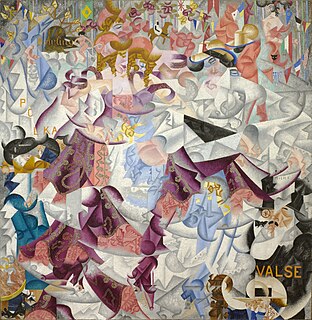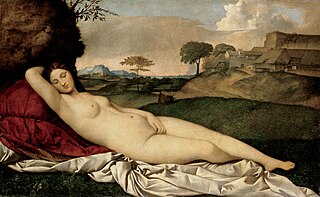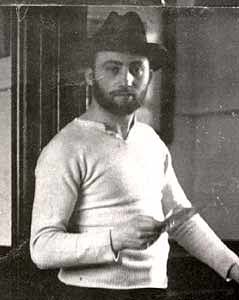
David Garshen Bomberg was a British painter, and one of the Whitechapel Boys.

Umberto Boccioni was an influential Italian painter and sculptor. He helped shape the revolutionary aesthetic of the Futurism movement as one of its principal figures. Despite his short life, his approach to the dynamism of form and the deconstruction of solid mass guided artists long after his death. His works are held by many public art museums, and in 1988 the Metropolitan Museum of Art in New York City organized a major retrospective of 100 pieces.
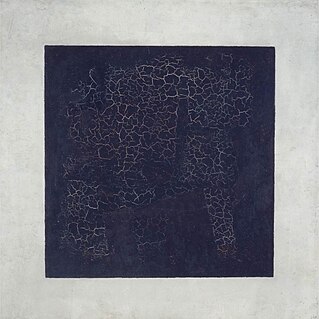
Suprematism is an art movement, focused on basic geometric forms, such as circles, squares, lines, and rectangles, painted in a limited range of colors. It was founded by Kazimir Malevich in Russia, around 1913, and announced in Malevich's 1915 exhibition, The Last Futurist Exhibition of Paintings 0.10, in St. Petersburg, where he, alongside 13 other artists, exhibited 36 works in a similar style. The term suprematism refers to an abstract art based upon "the supremacy of pure artistic feeling" rather than on visual depiction of objects.
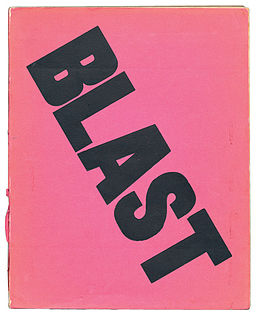
Blast was the short-lived literary magazine of the Vorticist movement in Britain. Two editions were published: the first on 2 July 1914 and published with a bright pink cover, referred to by Ezra Pound as the "great MAGENTA cover'd opusculus"; and the second a year later on 15 July 1915. Both editions were written primarily by Wyndham Lewis. The magazine is emblematic of the modern art movement in England, and recognised as a seminal text of pre-war 20th-century modernism. The magazine originally cost 2/6.

Gino Severini was an Italian painter and a leading member of the Futurist movement. For much of his life he divided his time between Paris and Rome. He was associated with neo-classicism and the "return to order" in the decade after the First World War. During his career he worked in a variety of media, including mosaic and fresco. He showed his work at major exhibitions, including the Rome Quadrennial, and won art prizes from major institutions.

Natalia Sergeevna Goncharova was a Russian avant-garde artist, painter, costume designer, writer, illustrator, and set designer. She was a founding member of both the Jack of Diamonds, Moscow's first radical independent exhibiting group, and the art movement known as Der Blaue Reiter. Born in Russia, she moved to Paris in 1921 and lived there until her death.

Edward Alexander Wadsworth was an English artist, most famous for his close association with Vorticism. He painted, often in tempera, coastal views, abstracts, portraits and still-life. He was also an engraver on wood and copper. In the First World War he was involved in transferring dazzle camouflage designs onto ships for the Royal Navy, and after the war he continued to paint nautical themes.

The Estorick Collection of Modern Italian Art is a museum in Canonbury Square in the district of Islington on the northern fringes of central London. It is the United Kingdom's only gallery devoted to modern Italian art and is a registered charity under English law.

Nude Descending a Staircase, No. 2 is a 1912 painting by Marcel Duchamp. The work is widely regarded as a Modernist classic and has become one of the most famous of its time. Before its first presentation at the 1912 Salon des Indépendants in Paris it was rejected by the Cubists as being too Futurist. It was then exhibited with the Cubists at Galeries Dalmau's Exposició d'Art Cubista, in Barcelona, 20 April–10 May 1912,. The painting was subsequently shown, and ridiculed, at the 1913 Armory Show in New York City.

Ilia Mikhailovich Zdanevich, known as Iliazd, was a Georgian and French writer and artist, and an active participant in such avant-garde movements as Russian Futurism and Dada.
George Costakis was a collector of Russian art whose collection became the most representative body of Modern Russian avant-garde art anywhere. In the years surrounding the 1917 revolution, artists in Russia produced the first non-figurative art, which was to become the defining art of the 20th century. Costakis by chance discovered some constructivist paintings in a Moscow studio in 1946, and he went on to search for the revolutionary art which might otherwise have been lost to the world.

Henryk Gotlib was a Polish-born painter, draughtsman, printmaker, and writer, who settled in England during World War II and made a significant contribution to modern British art. He was profoundly influenced by Rembrandt, and the European Expressionist painters. Gotlib was a leading member of the Polish avant-garde 'Formist' movement in the interwar Poland.
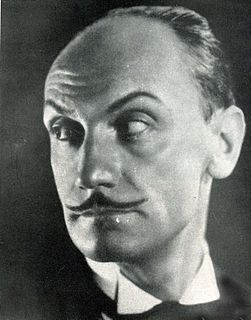
Anton Giulio Bragaglia was a pioneer in Italian Futurist photography and Futurist cinema. A versatile and intellectual artist with wide interests, he wrote about film, theatre, and dance.

Gerardo Dottori was an Italian Futurist painter. He signed the Futurist Manifesto of Aeropainting in 1929. He was associated with the city of Perugia most of his life, living in Milan for six months as a student and in Rome from 1926-39...

The Stafford Gallery was an early 20th-century art gallery in London. Artists whose works were exhibited there include both internationally known painters such as Pablo Picasso, Paul Gauguin, Paul Cézanne and Gustave Courbet and significant English figures such as Walter Sickert and Sir William Nicholson.
Better Books was an independent bookstore. It was founded by Tony Godwin and was located at 94 Charing Cross Road, London. The shop was a significant location in the 1960s counterculture movement in London.

Michael Vasilyevich Matyushin was a Russian painter and composer, leading member of the Russian avant-garde. In 1910–1913 Matyushin and his wife Elena Guro (1877–1913) were key members of the Union of the Youth, an association of Russian Futurists. Matyushin, a professional musician and amateur painter, studied physiology of human senses and developed his own concept of the fourth dimension connecting visual and musical arts, a theory that he put to practice in the classrooms of Leningrad Workshop of Vkhutein and INHUK (1918–1934) and summarized in his 1932 Reference of Colour .Matyushin conducted experiments at his Visiology Center (Zorved) to demonstrate that expanding visual sensitivity from retinian optical centers would enable the discovery of "new organic substance and rhythm in the apprehension of space." He tried to teach himself and his students to see with both eyes, each independently, and to widen the field of their vision. He describes some of his work and ideas in a long essay titled "An Artist's Experience of the New Space."
Sidney Hunt (1896–1940) was a British draughtsman, painter, poet and editor who published the avant-garde journal Ray between 1926 and 1927.
Vicomte Gilbert de Rorthays was a French art critic, art dealer, and the Paris correspondent for The Burlington Magazine.


